
Alexander Duff, was a Christian missionary in India; where he played a large part in the development of higher education. He was a Moderator of the General Assembly and convener of the foreign missions committee of the Free Church of Scotland and a scientific liberal reformer of anglicized evangelism across the Empire. He was the first overseas missionary of the Church of Scotland to India. On 13 July 1830 he founded the General Assembly's Institution in Calcutta, now known as the Scottish Church College. He also played a part in establishing the University of Calcutta. He was twice Moderator of the Free Church of Scotland in 1851 and 1873, the only person to serve the role twice.
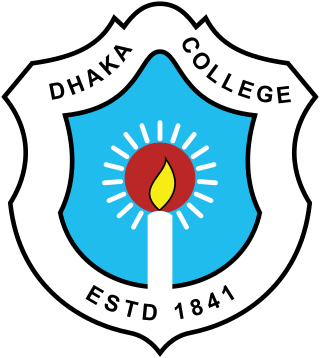
Dhaka College also known as DC is one of the most important as well as the earliest higher secondary educational institution of Bangladesh located in Dhanmondi, Dhaka. It offers higher secondary education. It has Honours and Master's programs as well which are affiliated with the University of Dhaka.
Salt Lake School is a co-educational school situated in Salt Lake City, Kolkata, India. This institution not only focuses on the academics, but also sports and several other co-curricular aspects of the students. Few alumnus of Salt Lake School have secured an all-India rank in competitive examinations.
Madhyamik Pariksha or simply Madhyamik is a centralized examination conducted by the West Bengal Board of Secondary Education in West Bengal, India, at the end of the 10th year of school education. Similarly, one examination is also conducted at the state of Tripura for its students studying in Govt or Govt Aided school under the control of Tripura Board of Secondary Education. By count of examinees, it is among the better-known 10th standard examinations in India. In WBSE, over 600,000 students took the exam in 2000, and the number has increased substantially since then. The number of students reached a record 1 million in the 2011 Madhyamik examination. Compulsory subjects are first language, second language, physical science, life science, mathematics, history and geography.
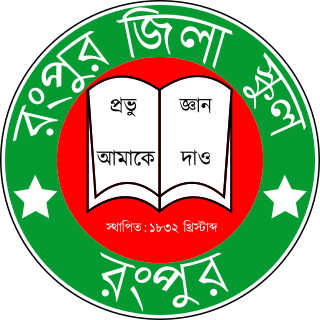
Rangpur Zilla School is a school located in Rangpur District, Bangladesh. It is one of the earliest schools established in Bengal.

North Dum Dum is a city and a municipality of North 24 Parganas district in the Indian state of West Bengal. It is a part of the area covered by Kolkata Metropolitan Development Authority (KMDA). Kolkata Airport is located nearby.

South Dum Dum is a city and a municipality of North 24 Parganas district in the Indian state of West Bengal. It is a part of the area covered by Kolkata Metropolitan Development Authority (KMDA) and a vital locality in Kolkata Metropolitan Area.
National High School is a two-campus school in South Kolkata, in the state of West Bengal, India. While one campus is affiliated to the West Bengal Board of Secondary Education and the West Bengal Council of Higher Secondary Education, the other is affiliated with the Central Board of Secondary Education.

Shyamnagar is a city in Bhatpara Municipality of North 24 Parganas district in the Indian state of West Bengal. It is a part of the area covered by Kolkata Metropolitan Development Authority (KMDA). The locality is considered one of the major development hubs in the district. It is sometimes also referred to as Barrackpore-Shyamnagar as it comes after Barrackpore.
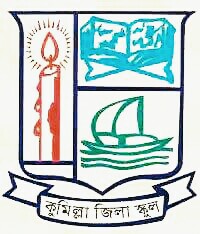
Comilla Zilla School is a boys' school in Comilla, a city in Bangladesh. It is one of the oldest schools in the country. It was the only school in Comilla when it was established in 1837.It is the best school under Comilla Board and as well as one of the top 10 rank school in overall Bangladesh

St. Lawrence High School is a private Catholic primary and secondary school for boys, located in Kolkata, West Bengal, India. It is among the top 5 schools in Kolkata. The school was founded in 1810 and run by the Jesuits, initially in Baithakhana, Sealdah, as an elementary school which came to be known as St. John Chrysostom School. It was renamed in January 1937 by Fr. Lawrence Rodriques, S.J. as St. Lawrence High School. The school caters for approximately 3,000 students.

Patha Bhavan is an English Medium private co-educational day school in Kolkata, India, which is affiliated to the state secondary and higher secondary boards. It is one of the old schools in kolkata. It was established on 28 June 1965.
Burdwan C.M.S. High School is a school in Bardhaman, West Bengal, India, standing by the side of B.C. Road. The school is divided into four categories: KG Section, Primary, Secondary, Higher Secondary, offering school education from KG1 to Higher secondary(+2) to more than 2000 students in the town.

Sanskrit Collegiate School is one of the oldest schools in Kolkata, India, teaching grades from class 1 to 12 under the West Bengal Board of Secondary Education and the West Bengal Council of Higher Secondary Education. The boys-only school was established by the then Bengal intelligentsia along with Sanskrit College, Calcutta. The establishment date is 1 January 1824. It is situated opposite the Presidency University, Kolkata, College Square and Hindu School, Kolkata and next to the University of Calcutta and Hare School, Kolkata.
Taki Government High School is a school in Taki, West Bengal, India. Located by the side of the Ichhamati River, it is the oldest existing schools in Taki.
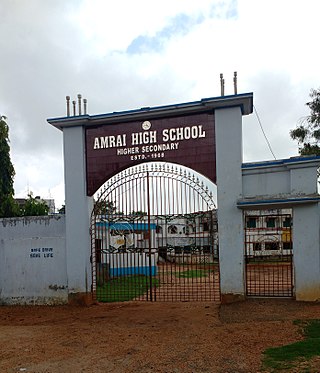
Amrai High School, Durgapur is a Bengali-medium senior secondary, co-ed, WBBSE and WBCHSE affiliated school in Durgapur steel city in the state of West Bengal, India. Amrai High School was established in 1968.
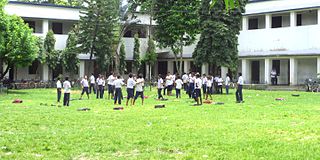
Islampur High School is located in the area ward no. 10 of Islampur Municipality in Islampur City, North Dinajpur, West Bengal, India. This school is situated near the New Bus Stand and is beside NH31.

The West Bengal Board of Madrasah Education is the state government administered autonomous examining authority for affiliated and recognized madrasahs in West Bengal, India. Perhaps among the oldest post-secondary boards in India, it is the only madrasah board that is recognized by the Government of India. It is one of the parastatal organization of the Minority Affairs and Madrasah Education Department. The West Bengal Board of Madrasah Education is the West Bengal state government administered autonomous examining authority for the High Madrasah examination of West Bengal, India. It has come into force by the West Bengal Board of Madrasah Education Act-1994.
Ukhrid High School, located at the heart of Ukhrid, a small-town bazar 15 km south-west of Bardhaman, is one of the oldest boys' and girls' schools in India. The school was established in 1925 in Khandaghosh CD Block. It has about 1050 students. It is an upper primary and higher secondary school.

Government Sponsored Multipurpose School (GSMS) for Boys, Taki House is a school in Kolkata, West Bengal, India. Its main campus is located in 299B Acharya Prafulla Chandra (APC) Road, Kolkata, started in the year 1965.















